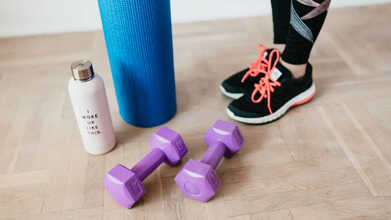- Health Conditions A-Z
- Health & Wellness
- Nutrition
- Fitness
- Health News
- Ayurveda
- Videos
- Medicine A-Z
- Parenting
Strong Shoulders, Better Posture: 20 Best Shoulder Exercises For Sculpted Upper Body

Credit: Canva
Consistent shoulder training can not only give your upper body a toned, strong appearance, but it also plays a significant role in injury prevention, stability, and posture.
Biceps and triceps may often get all the attention when it comes to upper-body strength, but the real foundation lies in your shoulders. These muscles are not only crucial for maintaining proper posture but also play a vital role in functional movement—whether it’s flowing through yoga poses or lifting weights, light or heavy.
Strong shoulders help stabilize the inherently unstable shoulder joint. According to strength coach Geoff Rose, CPT, "The muscles around our shoulder blade have a profound effect on how our shoulder moves. If those muscles aren’t working in unison—if one is tighter or stronger than the other—it can result in pain or even injury."
Why Shoulder Training Matters
To achieve well-rounded strength (and that sculpted upper body many aspire to), it’s important to train all the major muscles surrounding the shoulder joint:
- Deltoids: The three muscles covering the outside of your shoulder
- Trapezius: The muscles that run from the neck and spine to the shoulder blades
- Lats: The large back muscles running from the spine to the armpits
- Rotator Cuff: A group of muscles that keeps the upper arm bone snug in the shoulder socket
Because the shoulders are involved in most upper-body movements, a dedicated shoulder workout once a week can suffice. Alternatively, you can mix shoulder-targeting exercises into your full-body sessions.
Getting Started: Light and Steady Wins the Race
Shoulder muscles are delicate, so it’s perfectly fine to start with lighter weights (3–5 pounds) or resistance bands. Don’t have equipment? No problem—bodyweight and mobility-focused shoulder movements are just as effective.
Here Are Tips To Build A Shoulder Workout
- Time: 25 minutes
- Equipment: Dumbbells, resistance bands (or bodyweight)
- Target Area: Shoulders
Instructions: Choose 3 to 5 exercises from the list below. Perform 3 sets of the suggested reps for each movement, resting between sets as needed. Once complete, move on to the next exercise.
20 Effective Shoulder Exercises For All Levels
1. Upright Row – 15 reps
2. Banded Pull-Aparts – 10 reps
3. Halo (with Dumbbell) – 10 reps per direction
4. Reverse Snow Angel – 12–15 reps
5. Inverted Push-Up – 10 reps
6. Shoulder Complex – 10 reps
7. Tabletop Lift – 10 reps
8. Kettlebell Squat to Overhead Press – 10 reps
9. Front Raise – 12 reps
10. Plank Push-Up with Shoulder Retraction – 10 reps
11. Lateral Raise – 12 reps
12. Bent-Over Rear Delt Fly – 12 reps
13. Half Turkish Get-Up – 10 reps per side
14. Lying T-Lift – 15 reps
15. Serratus Punch – 12–15 reps
16. Plank Shoulder Taps – 12–15 reps
17. Single-Arm Overhead Press – 15 reps per side
18. Banded Shoulder Press – 10 reps
19. Bear Plank Shoulder Tap – 10 reps per side
20. Seated Overhead Press – 15 reps
Trying To Get Fit In 2026? Here’s A 6-Step Weight-Loss Plan From A Fitness Coach

Credits: Canva
When it comes to losing weight, most people put all their energy into workouts and diet plans, often forgetting one crucial part of the process: mindset. How you think about fitness, food, and consistency plays a major role in whether weight loss feels like a struggle or becomes a sustainable habit. Shifting your approach can make shedding extra kilos feel more manageable and long-lasting.
If staying healthy and losing weight are the goals for the coming year, Raj Ganpath, a fitness coach with over 18 years of experience and the founder of The Quad in Chennai, shares six simple but effective principles to keep in mind. He outlined these points in an Instagram post on 29 December.
6-Step Weight-Loss Plan From A Fitness Coach
1. Eat Less
“You need to eat less,” Raj says plainly. However, he said that this does not mean starving yourself or cutting out all your favourite foods. Instead, it is about being mindful of portion sizes and recognising how often we tend to overeat without realising it. According to him, consistent overeating is one of the most common reasons people struggle to lose weight. Paying attention to how much you eat, even when the food is healthy, can make a noticeable difference over time.
2. Eat Well
Eating less alone is not enough if the quality of food is poor. Raj explains that eating well means choosing nutrient-dense foods that support your body. This includes prioritising protein, vegetables, and whole foods, while reducing items that offer little nutritional value. Sugary snacks, deep-fried foods, and heavily processed or starchy items may be comforting, but they do not help when weight loss is the goal. Making better food choices more often than not builds a strong foundation for fitness.
3. Exercise Regularly
Consistency matters more than intensity. Raj advises exercising at least three days a week, with an ideal range of five to six days if possible. The exact form of exercise is less important than showing up regularly. However, he stresses that strength training should be included at least twice a week. Building muscle supports metabolism and overall strength, making weight loss more effective and sustainable in the long run.
4. Move Often
Exercise sessions alone are not enough if the rest of the day is spent sitting. Raj encourages regular movement throughout the day, separate from structured workouts. Simple activities like walking more frequently can add up. He suggests aiming for at least 6,000 steps daily, with 8,000 or more being a better target. This kind of movement supports fat loss, improves circulation, and keeps the body active beyond the gym.
5. Sleep More
Sleep is often ignored, yet it plays a direct role in weight management. “Most of us don’t sleep enough,” Raj points out. Even going to bed 20 to 30 minutes earlier each night can help. He recommends a minimum of six hours of sleep, with seven hours being ideal. Proper rest supports hormone balance, recovery, and energy levels, all of which influence appetite, motivation, and workout performance.
6. Manage Stress
Stress is unavoidable, and Raj acknowledges that no one can live a completely stress-free life. What matters is how stress is handled. Managing stress allows you to stay consistent with healthy habits instead of turning to food, skipping workouts, or neglecting sleep. Whether it is through exercise, meditation, time outdoors, or personal downtime, finding ways to cope with stress is essential for long-term health and weight loss.
Diet And Exercise Works Together For Weight Loss
Weight loss is most effective when diet and exercise work hand in hand. Diet helps create the calorie deficit needed for fat loss, while exercise protects muscle mass, boosts metabolism, and improves heart and bone health.
Strength training is especially important because muscle burns more calories at rest. While diet controls calorie intake, exercise prevents muscle loss, which can otherwise slow metabolism. Together, they create a balanced and sustainable approach that supports lasting results, healthier habits, and reduced chances of regaining weight.
7 Science-Backed Tips For Healthy Aging, According To Cardiologist

Credits: iStock
Everyone wants to age better, look young, stay young, even at heart. Celebrities like Bryan Johnson, too is obsessed with living forever. While living forever may not be a thing now, but Dr Eric Topol, cardiologist, tells the Wall Street Journals that there are ways one could age in a healthy way.
Dr Topol wanted to see if there were in fact "super agers", people who were born with genes that would help them age better. However, the key is in how they take care of their bodies and not necessarily in the genes. Topol, who is now 70, told the publication that he is now taking his own advice on healthy aging.
Here are the 7 science-backed tips he shared:
Exercise
"I’ve always been an exercise enthusiast. As a cardiologist, I always used to think, do aerobic exercise. But all the studies show resistance or strength training is really important too," he says. As per the National Institute on Aging, US, resistance training is crucial for aging because it combats age-related muscle loss (sarcopenia), boosts metabolism, strengthens bones, improves balance, enhances cognitive function, and supports heart or metabolic health, helping older adults stay mobile, independent, and reduce disease risk, making it a powerful anti-aging strategy for body and mind.
Sleep
The doctor explains that "many people think they need eight hours of sleep. Studies show seven hours is optimum. I’ve learned how important it is to have a set and early bed time. I’ve been able to increase my average deep sleep substantially by having my data and learning how what I eat and when I exercise affect it." He says that he used Apple smartwatch to track his sleep.
Diet
The doctor shares that he is especially "religious" about reading labels on the food items he buys. “Ultra-processed foods should be reduced to the lowest amount possible. When I read labels for things like whipped cream cheese or different brands of ice cream, they are chock-full of ultra-processed ingredients,” he shares.
Read: The Longevity Diet: Bryan Johnson Eats 3 Meals In 6 Hours—With Extra Virgin Olive Oil
What can you eat? Dr Topol mostly eats salad, with oil-and-vinegar dressing, packed with protein like salmon or chicken.
Protein
The doctor says that protein is a must. He says that the dietary allowance for protein is 0.8 grams per kilogram of a person’s weight for adults. However, he does warn people against overdoing on protein intake, as studies show that very high protein diets could lead to atherosclerosis.
Testing
Repeated testing and screening is a key to lead a healthy life. “I am trying to assemble a full stack of data we all need. I have had my genome sequenced, my gut microbiome tested, I have used organ clocks...There are anywhere between 6,000 and 11,000 proteins in your blood that can tell about the aging of organs...” he says.
Daily screening also help one stay ahead of any disease, as early detection could lead to shorter span of disease and has a better recovery rate.
Aging Supplements
“I don’t think any antiaging supplements have been proven. Taurine is a possible candidate. As we age, we see lower levels of taurine in the blood, and that is correlated with more inflammation,” he says. He, however also warns that these supplements need trials.
He also warns against Rapamycin, which is an FDA approved drug. It is used to help prevent organ rejection in transplant patients by suppressing the immune system. Dr Topol points out, “the last thing you want to do as you get older is to suppress the immune system”.
Mental Health
His advice to his patient is to spend more time outdoors. He says that he too has started doing the same thing.
5 Fitness Trends That Took Over Gyms And Social Media In 2025

Credits: Canva
An estimated 80% of Americans said they took part in sports or fitness activities over the past year, marking a record high, according to a 2025 report. From TikTok-driven routines to throwback military-style training and tech-powered workouts, this year’s fitness trends promised visible results with fairly simple steps. Experts, however, caution that not every trend delivers the same benefits. Below is a look at five fitness trends from 2025 that captured widespread attention online.
5 Fitness Trends That Went Viral in 2025
12-3-30 Treadmill Trend
The 12-3-30 treadmill workout became a social media favorite for its straightforward format: walking at a 12% incline, 3 miles per hour, for 30 minutes. Popularized by influencer Lauren Giraldo, it is often promoted as a weight-loss friendly, low-impact cardio option. The incline helps activate the glutes and hamstrings more than walking on a flat surface, while still feeling manageable for beginners. Fitness experts note that results depend on regular practice, maintaining good posture, avoiding the handrails, and easing into the routine to prevent strain.
Brazilian Jiu-Jitsu
With public figures like Ivanka Trump and Gisele Bündchen sharing their involvement, Brazilian Jiu-Jitsu has seen renewed interest as both exercise and self-defense training. BJJ is a grappling-based martial art that focuses on ground techniques, balance, and leverage, allowing smaller individuals to control stronger opponents. Beyond physical conditioning, it encourages strategic thinking and mental focus, which has helped build loyal communities around the sport.
According to Fox News, Ivanka Trump and her family train with the Valente brothers in Miami, Florida. The instructors describe jiu-jitsu as a discipline that supports physical, mental, and emotional growth, guided by their “7-5-3 code,” which emphasizes spiritual, mental, and physical well-being.
3-2-8 Fitness Method
The 3-2-8 method gained traction as a weekly fitness framework rather than a single workout. Created by instructor Natalie Rose, it includes three days of strength training, two days of Pilates or barre, and a daily goal of 8,000 steps. The approach is designed to support muscle tone, metabolism, and hormonal health, and has been especially popular among women seeking balance rather than burnout. By combining resistance work, low-impact core training, and consistent movement, the method aims to support fat loss and overall fitness without overwhelming the body.
TikTok’s 50-Jump Wake-Up Ritual
One of the simplest trends to take off in 2025 involved starting the day with 50 jumps right after getting out of bed. According to Fox News, the trend’s creator, Kathryn Smith, openly shared that discipline does not come naturally to her. “I am a lazy person by nature. I always have been. I'm never gonna do something that I don't want to do,” she said in her TikTok video. Despite its simplicity, the habit struck a chord with viewers, highlighting how short bursts of movement can help boost alertness and set the tone for the day.
Horseback Fitness
Animal-assisted workouts continued to grow in popularity in 2025, building on trends like Doga and goat yoga that blend exercise with time spent around animals. Among these, horseback fitness stood out. Horse riding, along with tasks like grooming and stable work, offers a full-body workout that improves balance, core strength, coordination, and cardiovascular health. Many programs also include off-horse exercises, such as Swiss ball movements, to mirror riding posture and engage the thighs and core. Beyond physical benefits, participants often point to the mental and therapeutic effects of working closely with horses.
© 2024 Bennett, Coleman & Company Limited

